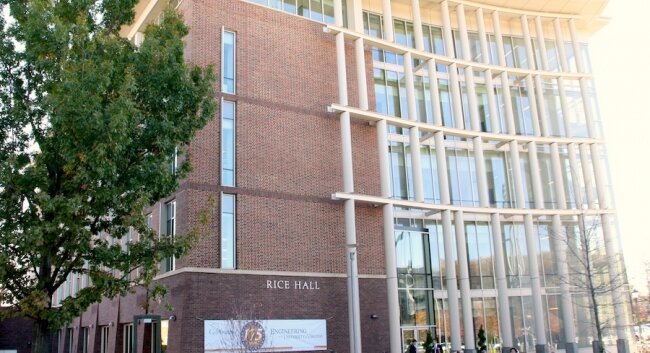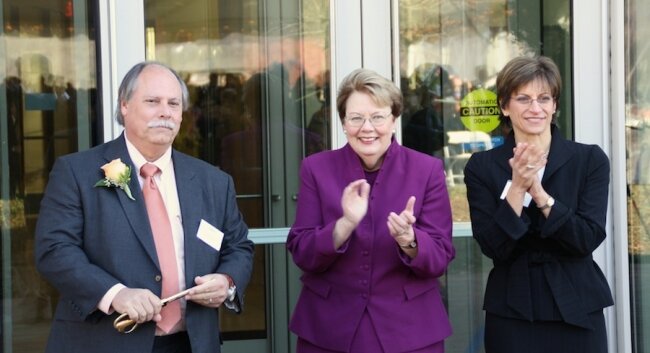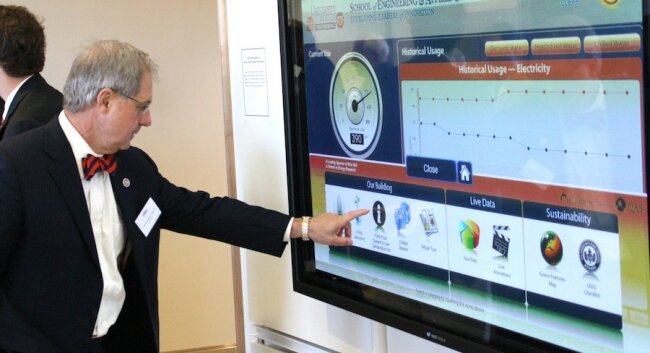Rice Hall: UVA cuts ribbon on $65 million smart building
-
 Rice Hall comes in the year that UVA celebrates the 175th anniversary of the engineering department's founding.hawes spencer
Rice Hall comes in the year that UVA celebrates the 175th anniversary of the engineering department's founding.hawes spencer -
 Benefactor Paul Rice, President Teresa Sullivan, Rector Helen Dragas.hawes spencer
Benefactor Paul Rice, President Teresa Sullivan, Rector Helen Dragas.hawes spencer -
 Technology investor and deep UVA donor Linwood Allen Lacy Jr. checks out energy consumption.hawes spencer
Technology investor and deep UVA donor Linwood Allen Lacy Jr. checks out energy consumption.hawes spencer
UVA officials cut the ribbon Friday morning on a $65 million building that can provide real-time reports on its own utility usage while educating the next wave of brainiacs. The November 18 event celebrated Rice Hall, a center for information technology engineering and a place that welcomes the future with several nods to the past.
The base of the structure, for instance, recalls that icon of postbellum urbanity, H.H. Richardson, with a sloped base that the lead architect calls a "batter." Executed in a dark-hued brick (as Richardson often did), the base leads up to areas of lighter brick, bands of contrasting stone and brick; and it's all capped with a deeply projecting cornice.
Unlike the cornices of Richardson's day, however, this one is streamlined. And in another bold break with the past, fully 40 percent of the structure's surface area is glass. At the entrance, which faces west-northwest, the glass is sheathed with a layer of steel for which even the designer doesn't seem to have a name.
"Modern portico screen thing would be good," says lead architect Roxanne Sherbeck, indulging a reporter's stab at a moniker. Discussing the unique steel curtain that shields the entrance and the westerly windows from the harshest sun, she says the design was inspired by Thomas Jefferson's colonnades, such as those on his famous Lawn– albeit in a vertical form.
Other sun-sensitive devices include sensors to reveal when it's time to shade a window to reduce the summer cooling load as well as water and electricity monitors to provide real-time efficiency reports.
Sherbeck is a principal with Pittsburgh-based Bohlin Cywinski Jackson, the firm that designed all the flagship Apple Computer stores, including the celebrated glass cube in Manhattan, and the California headquarters of Pixar Studios.
Rice Hall was named for the $10 million lead gift from 1975 engineering school grad Paul Rice and his wife Gina, through their Rice Family Foundation. The five-story plus basement structure stands at the corner of Whitewood and Stadium Roads near Scott Stadium.
Other opening-day festivities included a talk by Dean Kamen, the inventor who gave the world the first portable insulin infusion pump, a home dialysis system, and– to the delight of well-balanced oldsters and groovy crime-fighters– the Segway personal transporter.
2 comments
Hawes, you must be joking that this building brings to mind Richardsonian Romanesque architecture. I am a huge fan of Henry Hobson Richardson and his early work with brick is just a footnote to his eventual stone masterpieces.
County Farmer is right on point. Comparing this to building to Richardson's work is like comparing a Mcdonald's mansard roof to a French chateau.